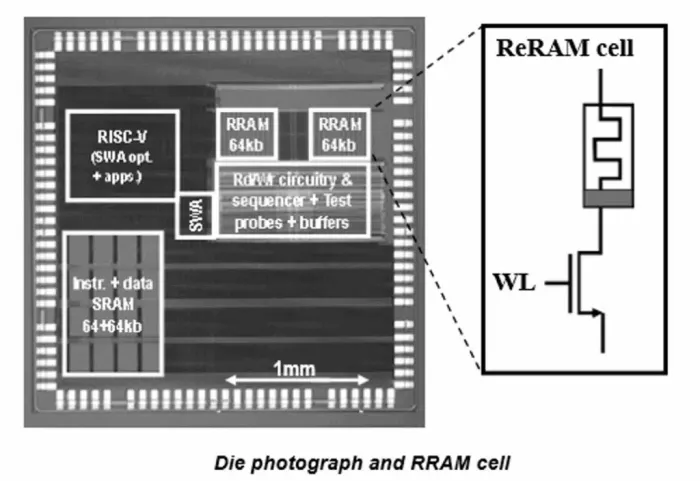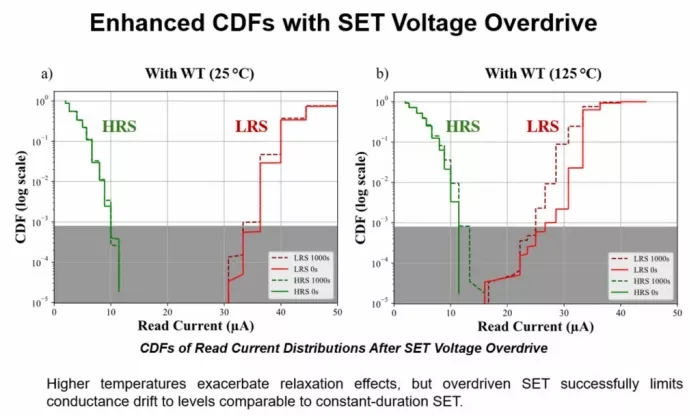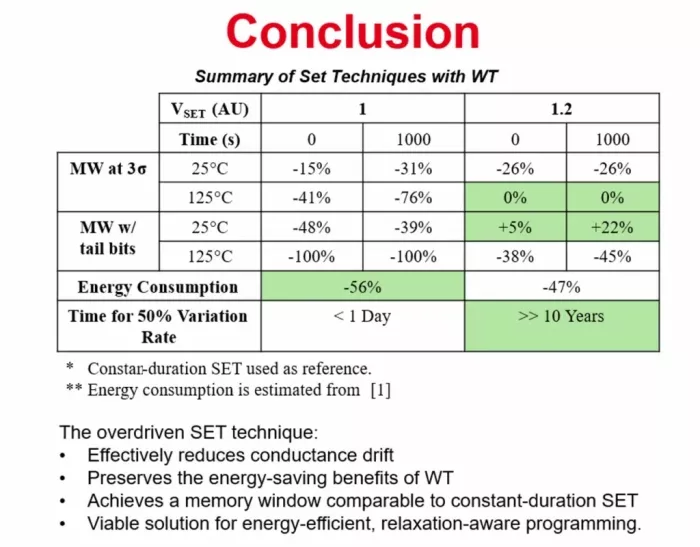Relaxation-Aware Programming in ReRAM: Evaluating and Optimizing Write Termination
Resistive RAM (ReRAM or RRAM) is the strongest candidate for next-generation non-volatile memory (NVM), combining fast switching speeds with low power consumption. New techniques for managing a memory phenomenon called ‘relaxation’ are making ReRAM more predictable — and easier to specify for real-world applications.
What is the relaxation problem in memory? Short-term conductance drift – known as ‘relaxation’ – presents a challenge for memory stability, especially in neuromorphic computing and multi-bit storage.
At the 2025 International Memory Workshop (IMW), a team from CEA-Leti, CEA-List and Weebit presented a poster session, “Relaxation-Aware Programming in RRAM: Evaluating and Optimizing Write Termination.” The team reported that Write Termination (WT), a widely used energy-saving technique, can make these relaxation effects worse.
So what can be done? Our team proposed a solution: a modest programming voltage overdrive that curbs drift without sacrificing the efficiency advantages of the WT technique.
Energy Savings Versus Stability
Write Termination improves programming efficiency by halting the SET (write) operation once the target current is reached, instead of using a fixed-duration pulse. This reduces both energy use and access times, supporting better endurance across ReRAM arrays.
It’s desirable, but problematic in action.
Tests on a 128kb ReRAM macro showed that unmodified WT increases conductance drift by about 50% compared to constant-duration programming.

In these tests, temperature amplified the effect: at 125°C, the memory window narrowed by 76% under WT, compared to a fixed SET pulse. Even at room temperature, degradation reached 31%.
Such drift risks destabilizing systems that depend on tight resistance margins, including neuromorphic processors and multi-level cell (MLC) storage schemes, where minor shifts can translate into computation errors or data loss.
The experiments used a testchip fabricated on 130nm CMOS, integrating the ReRAM array with a RISC-V subsystem for fine-grained programming control and data capture.
Conductance relaxation was tracked from microseconds to over 10,000 seconds post-programming. A high-speed embedded SRAM buffered short-term readouts, allowing detailed monitoring from 1µs to 1 second, while longer-term behavior was captured with staggered reads.
This statistically robust setup enabled precise analysis of both early and late-stage relaxation dynamics.
To measure stability, the researchers used a metric called the three-sigma memory window (MW₃σ). It looks at how tightly the memory cells hold their high and low resistance states, while ignoring extreme outliers.
When this window gets narrower, the difference between a “0” and a “1” becomes harder to detect — making it easier for errors to creep in during reads.
By focusing on MW₃σ, the team wasn’t just looking at averages — they were measuring how reliably the memory performs under real-world conditions, where even small variations can cause problems.
Addressing Relaxation with Voltage Overdrive
Voltage overdrive is the practice of applying a slightly higher voltage than the minimum required to trigger a specific operation in a memory cell — in this case, the SET operation in ReRAM.
Write Termination cuts the SET pulse short as soon as the target current is reached. That saves energy, but it also means some memory cells are just barely SET. They’re fragile — sitting near the edge of their intended resistance range. That’s where relaxation drift kicks in: over time, conductance slips back toward its original state.
So, the team asked a logical question:
“What if we give the cell just a bit more voltage — enough to push it more firmly into its new state, but not so much that we burn energy or damage endurance?”
Instead of discarding WT, the team increased the SET voltage by 0.2 Arbitrary Units (AU) above the minimum requirement.
Key results:
- Relaxation dropped to levels comparable to constant-duration programming
- Memory windows remained stable at both room and elevated temperatures
- WT’s energy efficiency was mostly preserved, with only a ~20% increase in energy compared to unmodified WT

Modeling predicted that without overdrive, 50% of the array would show significant drift within a day. With overdrive, the same drift level would take more than 10 years, a timescale sufficient for most embedded and computing applications.
Balancing Energy and Stability
The modest voltage increases restored conductance stability without negating WT’s energy and speed benefits. Although the overdrive added some energy overhead, overall consumption remained lower than that of fixed-duration programming.
This adjustment offers a practical balance between robustness and efficiency, critical for commercial deployment.

As ReRAM moves toward wider adoption and is a prime candidate for use in neuromorphic and multi-bit storage applications, conductance drift will become a defining challenge.
The results presented at IMW 2025 show that simple device-level optimizations like voltage overdrive can deliver major gains without requiring disruptive architectural changes.
Check out more details of the research here.
Related Semiconductor IP
Related Blogs
- Oxford Digital Offers Small Audio DSP Core With Graphical Programming
- Programming AXI-ACE VIP to Generate Error Scenarios
- It's a SLAM Dunk Programming the Vision Q7 DSP
- Weebit ReRAM: NVM that's better for the planet
Latest Blogs
- Formally verifying AVX2 rejection sampling for ML-KEM
- Integrating PQC into StrongSwan: ML-KEM integration for IPsec/IKEv2
- Breaking the Bandwidth Barrier: Enabling Celestial AI’s Photonic Fabric™ with Custom ESD IP on TSMC’s 5nm Platform
- What Does a GPU Have to Do With Automotive Security?
- Physical AI at the Edge: A New Chapter in Device Intelligence
